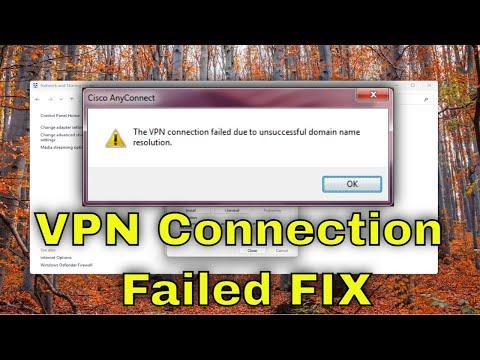It was a regular Tuesday when I first encountered the issue with my VPN connection. I had been using my VPN service without any problems for months, seamlessly connecting to my work network from my home office. But that day, something went wrong. I tried to connect as usual, but my VPN connection failed, and the error message that popped up was “VPN Connection Failed Due to Unsuccessful Domain Name Resolution.” I was at a loss and knew I had to fix it quickly because I had an important conference call scheduled.
I started troubleshooting by checking the basics. First, I verified that my internet connection was working. I could browse the web and access other online services without any issues, so the problem clearly wasn’t with my internet connection. Next, I checked my VPN credentials and server address to make sure they were correctly entered. Everything seemed fine there, too.
Then I decided to dive deeper into the issue. The error message specifically mentioned domain name resolution, which hinted that there might be a problem with how domain names are being resolved to IP addresses. My VPN client uses domain names to connect to the VPN server, so if there was a problem with this resolution, it would prevent the VPN from establishing a connection.
I started by restarting my VPN client and my computer, hoping that a simple reboot would fix the problem. Unfortunately, this did not resolve the issue. I then checked the settings of my VPN client. Everything appeared to be in order, but the connection still failed. At this point, I suspected that the issue might be related to my DNS settings.
I opened the network settings on my computer and looked at the DNS configuration. My computer was set to obtain DNS server addresses automatically, but I decided to manually specify DNS servers to see if that would make a difference. I entered the addresses for Google’s public DNS servers: 8.8.8.8 and 8.8.4.4. After applying the changes, I tried connecting to the VPN again. To my frustration, the connection still failed.
I realized I needed to take a more detailed approach. I decided to check the DNS settings on my router since the problem might be at the network level rather than on my individual computer. I accessed my router’s admin interface through my web browser. The router was set to use the ISP’s DNS servers by default. I changed the DNS settings to use Google’s public DNS servers, just like I did on my computer.
After updating the router’s DNS settings, I rebooted the router to ensure the changes took effect. I tried connecting to the VPN once more, but the issue persisted. This was becoming more complicated than I anticipated.
I decided to contact my VPN provider’s support team for assistance. They were quick to respond and asked for details about my issue. After describing the problem and the steps I had already taken, they suggested I check if there were any updates available for my VPN client. I was using an older version of the client, so I updated it to the latest version and restarted my computer.
With the updated VPN client, I tried connecting again, but the error remained. The support team then recommended checking my system’s hosts file. The hosts file can override DNS settings and map domain names to specific IP addresses. I located the hosts file on my computer and reviewed its contents. There were no unusual entries that could interfere with DNS resolution for my VPN.
Frustrated but determined, I took another approach. I decided to test the VPN connection on a different device using the same network. I installed the VPN client on my tablet and attempted to connect. To my relief, the connection was successful on the tablet. This indicated that the problem was likely related to my computer rather than the network or the VPN service itself.
I returned to troubleshooting my computer. I decided to check for any system updates that might be pending. Sometimes, updates can fix underlying issues that are not immediately apparent. I found that there were a few system updates available, so I proceeded with installing them.
After completing the updates and restarting my computer, I attempted to connect to the VPN once more. This time, I was greeted with a successful connection. The updates had likely addressed some underlying issue that was causing the DNS resolution problem.
To ensure the problem was fully resolved, I tested the VPN connection several times over the next few days. Each time, the connection was successful, and the error message did not reappear. It seemed that the combination of updating the VPN client, adjusting the DNS settings, and applying system updates had resolved the issue.
Reflecting on the experience, I realized that troubleshooting such issues requires a methodical approach and sometimes a bit of persistence. It’s important to start with basic checks and progressively move to more complex solutions if necessary. In this case, addressing the DNS settings, updating software, and seeking support when needed ultimately led to resolving the VPN connection problem.
